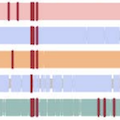Abstract
The COVID-19 pandemic caused by the novel coronavirus SARS-CoV-2 has spread globally, with >52,000 cases in California as of May 4, 2020. Here we investigate the genomic epidemiology of SARS-CoV-2 in Northern California from late January to mid-March 2020, using samples from 36 patients spanning 9 counties and the Grand Princess cruise ship. Phylogenetic analyses revealed the cryptic introduction of at least 7 different SARS-CoV-2 lineages into California, including epidemic WA1 strains associated with Washington State, with lack of a predominant lineage and limited transmission between communities. Lineages associated with outbreak clusters in 2 counties were defined by a single base substitution in the viral genome. These findings support contact tracing, social distancing, and travel restrictions to contain SARS-CoV-2 spread in California and other states.
